Ask the Pros: Split shots
Matt Smith
Matty Smith is a self confessed over/under photograph addict!!
What is your favorite lens for shooting over/under images? Please specify whether you are shooting full frame or cropped sensor. What size dome port do you use?
When shooting an over/under picture you are basically creating a window between two worlds where light and focus behave very differently.
Wide-angle lenses and fisheyes are essential if you want to achieve an image that is sharp all over; front to back above and below. However, great effects can be made using a standard or short telephoto lens, the rule is to experiment.
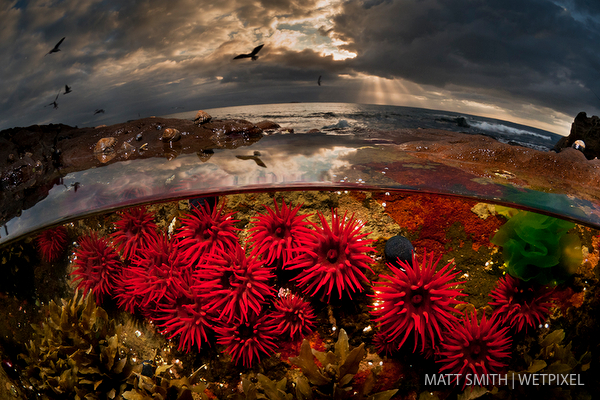
My dome selection depends on what lens I’m using, what subject I’m shooting, how close I want to get to my subject and whether I’m in confined calm water or open choppy seas. For a close focus wide angle over/under of a small subject such as a Portuguese Man o’ war I will use either my Aquatica 4” Glass dome port or Aquatica 8” acrylic dome port. This will be used in conjunction with a crop sensor Nikon camera and Nikkor 10.5mm fisheye because of the close focus capability and marvelous depth of field achievable.
For standard reef landscape type over/unders I use a full frame Nikon Camera with Nikkor 14-24mm and Aquatica 9.25mm Glass dome port.
However, I have designed an built my own huge 18” Acrylic dome port which I use with my Nikkor 14-24mm lens and this has several unique advantages. In open choppy seas a huge port like this doesn’t get swamped by the waves, it’s buoyancy helps it ride up and over the chop meaning it’s always in the perfect position to shoot over/under when you subject comes into frame. Also, due to it’s size the water line is pushed further away from the lens making it much thinner and less conspicuous in your shot. Depth of field is also greatly increased meaning I can shoot at wider apertures and I can also use more telephoto lenses for some quite unique effects. A 50mm lens in this huge port creates some melt in the mouth sharp images with a different perspective.
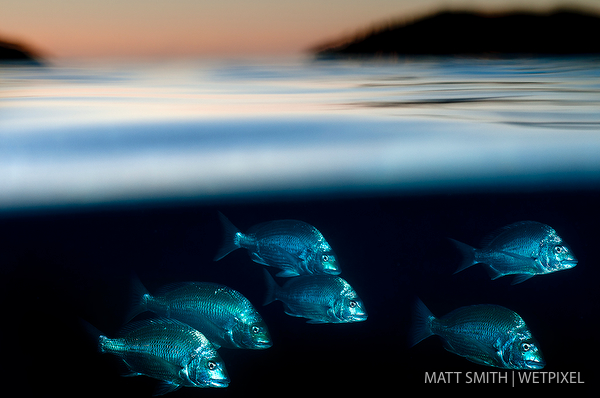
How do you expose the images? Do you use tools in post to adjust either underwater or above water exposures?
I always use my camera in manual made for over/under images and set an exposure for the sky, there’s nothing worse than blown out clouds!! For the under part I rely on my strobes for illumination, meaning I have to get quite close to my “under” subject. This will lead to minimal adjustment in post.
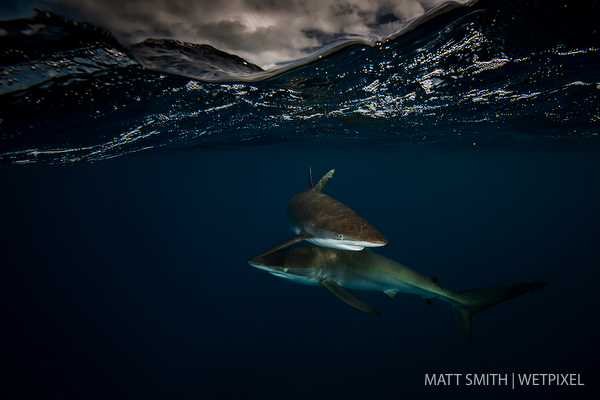
How do you shoot splits of fast moving animals?
Activate an autofocus sensor low in the frame so it’s always underwater, use fast lenses and have the reactions of a cat!

What makes for a great dive site for shooting over/unders? (Shallow reefs, sun angles etc.)
Shallow water is needed if you’re trying to achieve a landscape type of over/under, I always shoot at low tide over reefs etc. This ensures your strobes will cast plenty of illumination underwater and the sea bed will be close to your lens 1/2m a or less is ideal. I’m not a big fan of midday shooting, sunbeams and high contrast aren’t my thing, but that’s a personal choice. I will generally attempt this kind of image at sunrise, sunset or the stormier days when the light it more diffused and even.
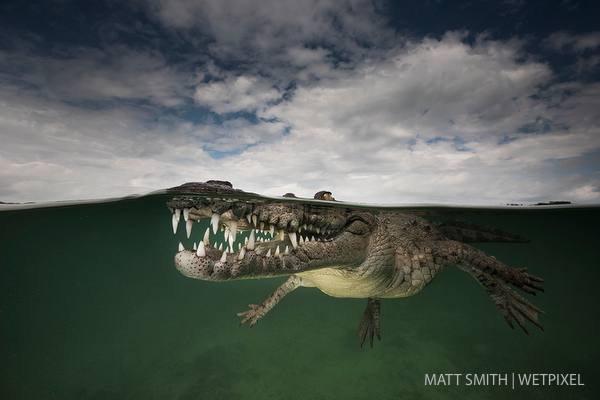
Why do you think over/unders are so popular with people? Do your split level shots sell well? In turn, do you set out to shoot them specifically for this?
I sell more over/under shots than anything else, but then again I shoot more over/under shots than anything else!! I think it’s because this type of photography visually peels back the layers of a world strange and mysterious to most, they get a window into the unknown.
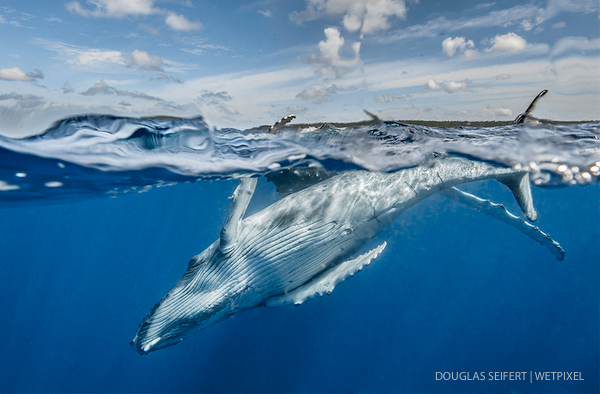
Douglas David Seifert: A PHOTOGRAPHIC SPLIT PERSONALITY
Douglas Seifert, World Editor at DIVE MAGAZINE, is the creator of Water Column — a regular feature in DIVE MAGAZINE showcasing in-depth natural history subjects and conservation features in words and images. He has been a published writer and award winning photographer of the underwater world for over 20 years.
Of course memory grows hazy over the decades, but as I recall, the Over/Under or Half/Half (as Europeans call it) or Split Shot was pioneered by David Doubilet and Doug Perrine in the late 1980’s or early 1990s, but as far as I am concerned, it was Jim Watt who really took the technique and ran with it (along with his partner in crime Berkley White). (Also, in the South Pacific, Darryl Torckler and Andy Belcher and Pete Atkinson made the technique their specialty; culminating with Darryl Torckler eventually commissioning a wrist-twisting dome that was nearly three feet in circumference).
Back in the film days, there wasn’t much ability to change exposure in post processing so the limitations were severe. There is generally, at least, a two to three stop difference between the correct “medium gray” above water exposure and the correct “medium gray” underwater exposure, which meant that one had to expose for the surface exposure and find shallow sandy bottom with a massive reflection or to utilize strobes to lighten the underwater portion. This meant that, originally, most subjects were stingrays over sand or manatees over sand. Further, due to the optical properties of water and dome ports, focus had a differential, which meant that in focus above and below water was achievable only via small apertures and using a fisheye lens (which has unsurpassed depth of field). Jim Watt had a number of filters built to enable the use of other lenses, such as the 20mm and 24mm primes. Jim’s filter experiments initially utilized light sensitive glass from eyeglasses technology that would darken when pointed into the sun; then evolved into a +3 diopter on the bottom half and a 3 stop gradient neutral density filter on the upper half. The results were fantastic but also limited – one had to have calm, flat water to mask the split features of the filter. Also, the filter had to be aligned just right in the housing and if it shifted in transit the shots were ruined.
Once he moved from film to digital (courtesy of “borrowing” Eric Cheng’s Canon D30 and German housing – appropriating it would be a more accurate term, eh Eric?), the gloves really came off on the constraints of Splits. Jim Watt preferred to use a fisheye and strobes to light subjects close to the camera (ideally just before hitting the dome) to good effect and to utilize the golden hour of sunset or sunrise to make images and to exclusively use fisheyes as close to the subject as possible. If Jimbo had patented the lemon shark at the swim step with suns setting behind split shot, most of today’s photographers would be paying royalties. Jimbo invented it, refined it; everyone else came later. Much later. Sorry folks…
I learned a lot from Jimbo and we, his close friends left behind, all miss him terribly. One of the last shoots we did together was of alligators in the Florida Everglades. I didn’t want to do it, go on the shoot, meddle with alligators with the reasoning “what would I do with the shot?” Jimbo was insistent “it would be fun” with Jimbo somehow finding fun in scorchingly hot Florida–in-August summer temperatures, incessant squadrons of savagely biting mosquitoes, and avoiding the police as getting close to alligators was a bit frowned upon (at a minimum). But how could you argue with the absolute child-like and over the top manic enthusiasm of Watt-Watt-Watt.
So I went.
We both used our housings, a fisheye lens and strobes (as well as a bag of “white trash junk food” which attracted the ‘gators to close proximity of our cameras).
We took turns.
It was a terrible experience.
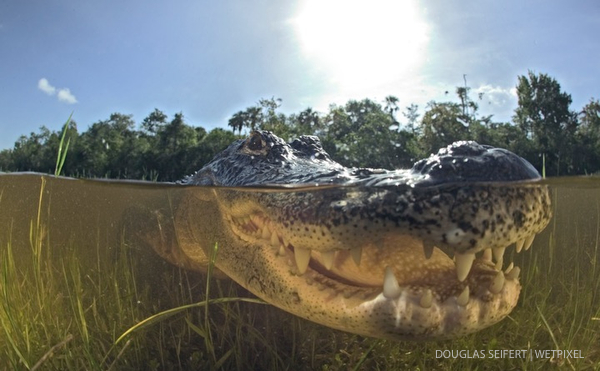
You had to wear so much insect repellent to keep the mosquitoes away that your skin’s pores were blocked, hence you sweated (no perspiring that was gone in the first minute) profusely, which caused the insect repellent to get to your eyes and sting, and tear up, and make it hard to focus on your surroundings AND the insect repellent rolling down your cheeks onto your lips, making them tingly then numb and saliva to start pooling so a lot of spitting and hacking followed. The heat and chemical poisoning made me dizzy, nauseous. It was really a horrible horrible experience made worse by Jimbo’s delight in nailing the images and really making unique images for the time.
All in all, the ‘gators were boring photo subjects really. They do.not.kill.adult. humans so the fear factor is gone. They are kind of rigid with unblinking eyes. Yes, they trigger fantasies of the prehistoric and appeal to our dreams of dinosaurs and they don’t move much so anyone with a basic understanding of how the camera works can photograph them, bravo! But it wasn’t any more natural behavior than a shark feed but minus the grace and majesty of sharks that are often distant without a stimulating incentive, so after an hour or so, I was ready to pull the plug on it. Besides, I didn’t know what I was going to do with the image anyway. Jimbo stayed another two days shooting ‘gator splits and even went back a few more times in the next few years.
I have no doubt his images are much more interesting, more creative than what I came back with. But coincidence and serendipity are powerful forces and by chance I was on the telephone with a reporter from the New York Times whom I had collaborated with on a story months before and he mentioned The Gray Lady had a feature in the pipeline on alligators and told me to send the photo editor my image tout de suite. The next week: My Split of the alligator was on the cover of the New York Times Science Section. Nine million views, minimum, (and a decent payday).
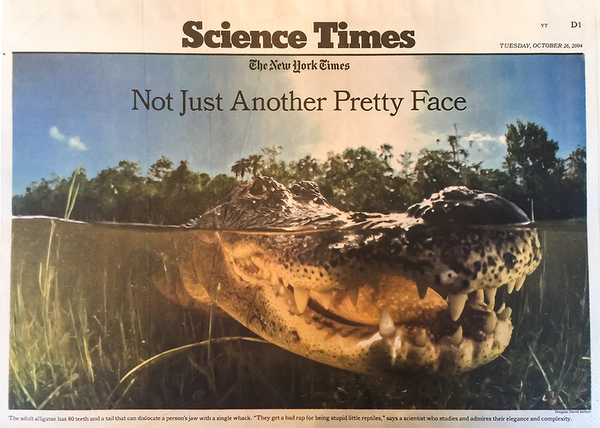
Jimbo called me a few days later and after making small talk and beating around the bush for ten minutes he asked me if I had something to tell him. I was smiling and laughing hysterically as I told him and confessed: “Thank you. You were right. And it was all because of you.” And Jimbo laughed too and took the compliment and grumbled halfheartedly knowing that sometimes the up and comers need a break a bit more than the established pros. It was very very cool and I am glad we did the shoot and it worked out as it did and for me that image will always be Jimbo’s even though I made it.
Sorry, what was the question?
Actually, I don’t do a lot of Splits (Over/Unders). I hate the process, especially when working with big animals. You are not going to have a dry dome, so the sheeting of seawater across the dome glass as expediently as possible to avoid blurred spots becomes the big concern. For the record, I shoot full frame with a 15mm Fisheye and 9 inch (230 mm) dome. I have tried a lot of things – spit/saliva (my own, get your own brand); Lemon Pledge (Howard Hall is said to swear by this but we have actually never discussed it) and my personal favorite/go-to — potato starch. Take a half a potato, rub it over the largest dome port you have just prior to the shot, and dunk the camera, letting the water sheet off the starch on your dome. I use a fisheye almost exclusively. Of course, it’s not always possible to have a potato in your wetsuit when you are in the South Pacific so really all you can do is your best., cross your fingers, shoot A LOT and hope for the best.
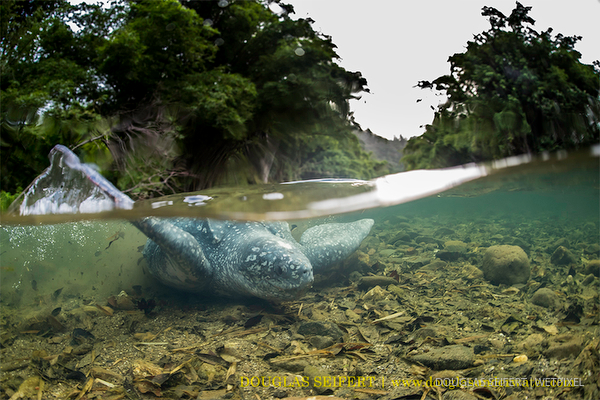
I don’t like making split shots because I find them gimmicky – which they unabashedly are – and I am not so interested in what goes on at the surface unless it’s a part of the story. However, I do like many other photographers’ split shots. I think of the time involved, the frustration, the other things you give up to concentrate on an image bridging two worlds. When the images work, they work; when they don’t, they just seem like a desperate photographer trying to make something from the mediocre. Great, ‘creatively’ speaking; so-so (meh!) from an aesthetic sensibility. Having said that, whenever I send in a batch of images to support a story, the art directors seem to gravitate towards the splits so I suppose if I wanted greater “success” I would have to make more split shots. Yawn.
The technical details: for splits, I usually have ISO 400 (Nikon) or 640 (Canon) as my base and I shoot 1/125 or higher, ideally trying to have an aperture of f/16. I set the camera to Tv of Shutter Priority because I want to freeze the big animal action and concentrate on the framing or not getting run over/slugged/hit/bitten (depending upon species) rather than fret about intermittent lighting changes caused by clouds.
The image is usually pretty close in Camera Raw, with the need to use a graduated neutral density filter for the above water segment (if not blown out) and some lightening/shadow on the underwater segment.
As I said, I am not a huge fan of these gimmicky shots, except when they work. Obviously, if someone will pay a fair rate for them, they work. But it doesn’t hold my interest if the sole point of the image is to show a human being in a boring underwater generic scene just for the sake of selling a brightly colored plastic snorkel, mask or fins. For that matter, I rarely have humans in my frames, period.
Page 1: David Doubilet, Franco Banfi, Cristian Dimitrius, Allison Vitsky Sallmon and Andy Sallmon.
Page 2: Matt Smith, Douglas Seifert.
Page 3: Mike Veitch, David Fleetham, Eiko Jones.
Page 4: Viktor Lyagushkin, David Salvatori, Becky Kagan Schott.
Page 5: Rico Besserdich, Julian Cohen, Berkley White.